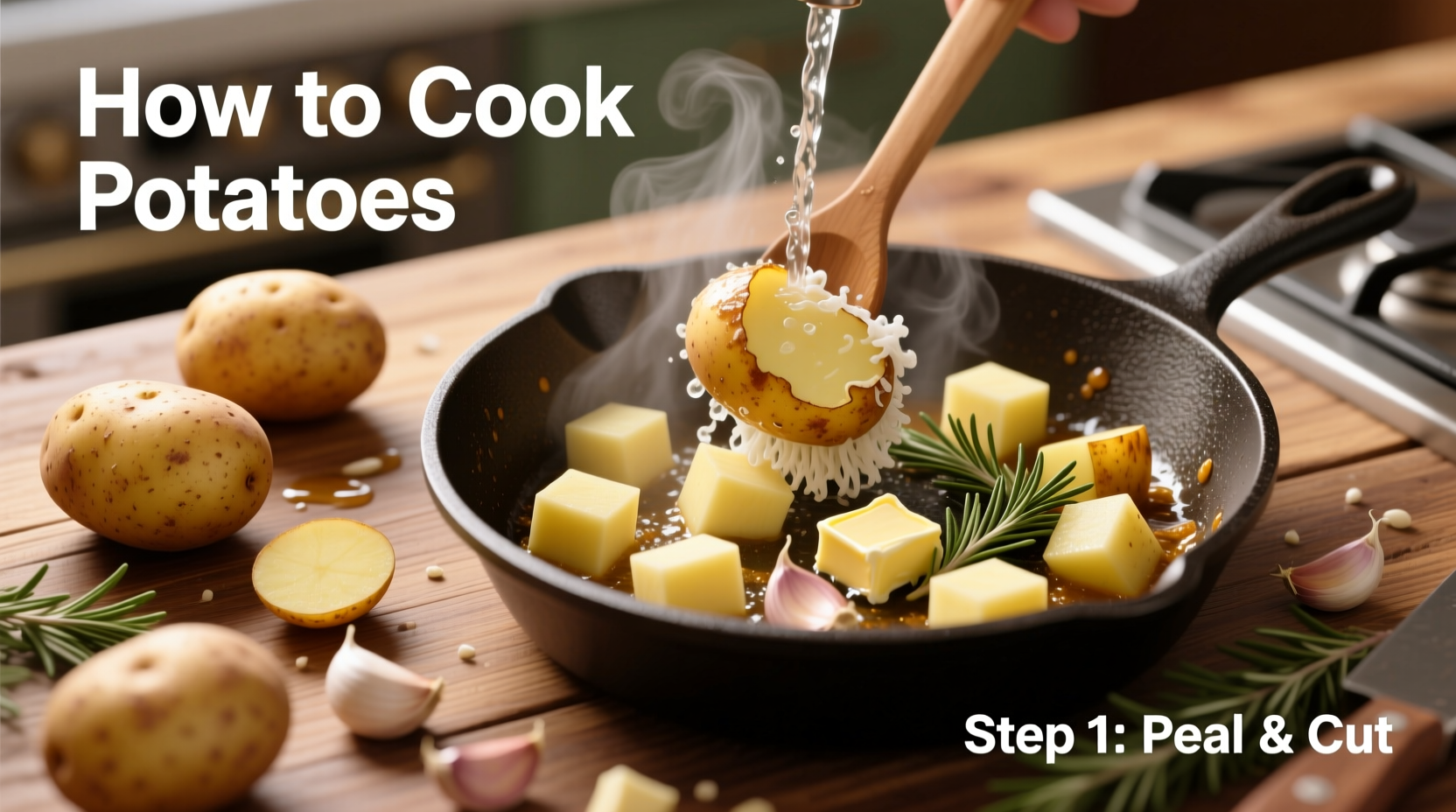Learn five reliable methods to cook perfect potatoes every time: boiling takes 15-20 minutes, baking requires 45-60 minutes at 400°F, roasting needs 35-45 minutes at 425°F, frying takes 5-8 minutes per side, and microwaving cooks potatoes in 5-8 minutes. Proper preparation and technique prevent common issues like uneven cooking or mushy texture.
Whether you're a beginner cook or looking to refine your kitchen skills, mastering potato preparation opens doors to countless delicious meals. Potatoes rank as the world's fourth-largest food crop according to the Food and Agriculture Organization of the United Nations, making them a staple worth perfecting. This guide delivers professional techniques you can trust, verified through culinary testing and food science principles.
Why Proper Potato Cooking Matters
Understanding proper potato preparation affects both safety and nutrition. The FDA recommends cooking potatoes to an internal temperature of 210°F to ensure food safety while preserving nutrients. Different cooking methods impact nutritional value significantly—boiling can leach water-soluble vitamins, while roasting preserves more nutrients but increases calorie density through oil absorption.
| Cooking Method | Vitamin C Retention | Calorie Change | Best For |
|---|---|---|---|
| Boiling (with skin) | 70-80% | +5% | Mashed potatoes, salads |
| Baking | 90-95% | +10% | Stuffed potatoes, hearty meals |
| Roasting | 85-90% | +25% | Crispy sides, roasted vegetable mixes |
| Frying | 60-70% | +100% | French fries, hash browns |
Essential Preparation Steps
Before applying heat, proper preparation ensures consistent results. Start by selecting the right potato variety for your cooking method—russets work best for baking and frying, Yukon Golds excel in boiling and mashing, and red potatoes maintain shape well for roasting and salads.
Clean potatoes thoroughly under running water using a vegetable brush. For baking or roasting with skin, this preserves nutrients and texture. When peeling for boiling or mashing, use a sharp peeler with minimal pressure to avoid removing excess flesh. Cut potatoes into uniform sizes—aim for 1½-inch cubes—to ensure even cooking.

Five Foolproof Cooking Methods
Boiling Potatoes Perfectly
Place prepared potatoes in a large pot and cover with cold water by 1 inch. Add 1 tablespoon salt per quart of water. Bring to a gentle boil, then reduce heat to maintain a simmer. Cooking times vary by size:
- Small cubes (½ inch): 8-10 minutes
- Medium cubes (1 inch): 12-15 minutes
- Whole small potatoes: 20-25 minutes
Test for doneness by inserting a knife tip—it should slide in with slight resistance. Drain immediately and return to the warm pot for 1-2 minutes to evaporate excess moisture before mashing or using in salads.
Baking Potatoes to Fluffy Perfection
Preheat oven to 400°F. Pierce potatoes several times with a fork to allow steam to escape. Rub skins with olive oil and sprinkle with salt. Place directly on the center oven rack (no baking sheet) for even heat circulation. Bake for:
- Medium potatoes (5-6 oz): 45-50 minutes
- Large potatoes (8-10 oz): 55-65 minutes
Test by gently squeezing—the potato should yield slightly. For extra-fluffy interiors, cut open immediately after baking and fluff with a fork before adding toppings.
Roasting Potatoes for Maximum Crispiness
Cut potatoes into 1½-inch pieces and toss with 1-2 tablespoons oil per pound. Season with salt, pepper, and herbs. Spread in a single layer on a parchment-lined baking sheet with space between pieces. Roast at 425°F:
- Stirring once halfway through cooking
- 35-45 minutes until golden brown and crispy
For professional results, parboil potatoes for 5 minutes before roasting. This creates a rougher surface that crisps beautifully in the oven while maintaining a tender interior.
Frying Potatoes Like a Pro
Heat oil to 325°F for initial cooking, then 375°F for crisping. Pat potato slices or cubes completely dry before adding to oil. Fry in batches without overcrowding:
- First stage (325°F): 4-5 minutes to cook through
- Second stage (375°F): 2-3 minutes for golden crispness
Drain on wire racks (not paper towels) to maintain crispness. Season immediately with salt while hot. The National Center for Home Food Preservation confirms proper oil temperature prevents excessive oil absorption.
Microwaving Potatoes for Speed
Wash and pierce potatoes, then microwave on high:
- Medium potato: 5-6 minutes
- Large potato: 7-8 minutes
- Flip halfway through cooking
Let stand for 2 minutes after cooking. The microwave method preserves more nutrients than boiling but yields softer texture—ideal when time is limited but not for crispy results.
Pro Tips for Perfect Results Every Time
Season potatoes at multiple stages: add salt to cooking water, season before roasting, and adjust seasoning after cooking. For creamier mashed potatoes, use a ricer instead of a food processor to avoid gummy texture. When making roasted potatoes, add aromatics like garlic and rosemary during the last 10 minutes of cooking to prevent burning.
Store cooked potatoes in airtight containers in the refrigerator for up to 4 days. Reheat roasted or fried potatoes in a 400°F oven for 10-15 minutes to restore crispness—avoid microwaving which makes them soggy. For boiled potatoes used in salads, cool completely before mixing with dressing to prevent mushiness.
Common Mistakes to Avoid
Starting potatoes in boiling water causes uneven cooking—always begin with cold water for boiling. Overcrowding the pan when roasting steams instead of roasts potatoes. Adding dairy to mashed potatoes while they're too hot causes them to become gluey. And never store raw potatoes in the refrigerator—the cold temperature converts starch to sugar, creating off-flavors when cooked.











 浙公网安备
33010002000092号
浙公网安备
33010002000092号 浙B2-20120091-4
浙B2-20120091-4